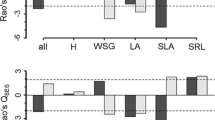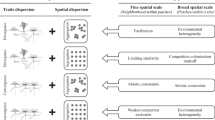Abstract
Evaluating community assembly through the use of functional traits is a promising tool for testing predictions arising from Niche and Coexistence theories. Although interactions among neighboring species and their inter-specific differences are known drivers of coexistence with a strong spatial signal, assessing the role of individual species on the functional structure of the community at different spatial scales remains a challenge. Here, we ask whether individual species exert a measurable effect on the spatial organization of different functional traits in local assemblages. We first propose and compute two functions that describe different aspects of functional trait organization around individual species at multiple scales: individual weighted mean area relationship and individual functional diversity area relationship. Secondly, we develop a conceptual model on the relationship and simultaneous variation of these two metrics, providing five alternative scenarios in response to the ability of some target species to modify its neighbor environment and the possible assembly mechanisms involved. Our results show that some species influence the spatial structure of specific functional traits, but their effects were always restricted to the finest spatial scales. In the basis of our conceptual model, the observed patterns point to two main mechanisms driving the functional structure of the community at the fine scale, “biotic” filtering meditated by individual species and resource partitioning driven by indirect facilitation rather than by competitive mechanisms.




Similar content being viewed by others
References
Adler PB, Fajardo A, Kleinhesselink AR, Kraft NJB (2013) Trait-based tests of coexistence mechanisms. Ecol Lett 16:1294–1306. doi:10.1111/ele.12157
Albert CH, De Bello F, Boulangeat I et al (2012) On the importance of intraspecific variability for the quantification of functional diversity. Oikos 121:116–126. doi:10.1111/j.1600-0706.2011.19672.x
Baddeley A, Turner R (2005) Spatstat: an R package for analyzing spatial point patterns. J Stat Softw 12(6):1–42. doi:10.18637/jss.v012.i06
Baddeley A, Diggle PJ, Hardegen A, Lawrence T, Milne RK, Nair G (2014) On tests of spatial pattern based on simulation envelopes. Ecol Monogr 84(3):477–489. doi:10.1890/13-2042.1
Bello D (2009) Partitioning of functional diversity reveals the scale and extent of trait convergence and divergence. J Veg Sci 20:475–486. doi:10.1111/j.1654-1103.2009.01042.x
Caballero I, Olano JM, Escudero A, Loidi J (2008) Seed bank spatial structure in semi-arid environments: beyond the patch-bare area dichotomy. Plant Ecol 195:215–223. doi:10.1007/s11258-007-9316-7
Cahill JF, Kembel SW, Lamb EG, Keddy PA (2008) Does phylogenetic relatedness influence the strength of competition among vascular plants? Perspect Plant Ecol Evol Syst 10:41–50. doi:10.1016/j.ppees.2007.10.001
Callaway RM (2007) Positive interactions and interdependence in plant communities. Springer, Dordrecht
Cavieres LA, Badano EI (2009) Do facilitative interactions increase species richness at the entire community level? J Ecol 97:1181–1191. doi:10.1111/j.1365-2745.2009.01579.x
Chacón-Labella J, De la Cruz M, Escudero A (2016) Beyond the classical nurse species effect: diversity assembly in a Mediterranean semiarid dwarf shrubland. J Veg Sci 27:80–88
Chesson P (2000) Mechanisms of maintenance of species diversity. Annu Rev Ecol Syst 31:343–366
Cornelissen JHC, Lavorel S, Garnier E et al (2003) A handbook of protocols for standardised and easy measurement of plant functional traits worldwide. Aust J Bot 51:335–380. doi:10.1071/BT02124
Cornwell WK, Ackerly DD (2009) Community assembly and shifts in plant trait distributions across an environmental gradient in coastal California. Ecol Monogr 79:109–126
Craine J, Elmore AJ, Aidar MPM et al (2009) Global patterns of foliar nitrogen isotopes and their relationships with climate, mycorrhizal fungi, foliar nutrient concentrations, and nitrogen availability. New Phytol. doi:10.1111/j.1469-8137.2009.02917.x
Dawson TE, Mambelli S, Plamboeck AH et al (2002) Stable isotopes in plant ecology. Annu Rev Ecol Syst 33:507–559. doi:10.1146/annurev.ecolsys.33.020602.095451
De la Cruz M, Romao RL, Escudero A, Maestre FT (2008) Where do seedlings go? A spatio-temporal analysis of seedling mortality in a semi-arid gypsophyte. Ecography 31:1–11. doi:10.1111/j.2008.0906-7590.05299.x
Díaz S, Lavorel S, De Bello F et al (2007) Incorporating plant functional diversity effects in ecosystem service assessments. Proc Natl Acad Sci USA 104:20684–20689
Ehrenfeld JG, Ravit B, Elgersma K (2005) Feedback in the plant-soil system. Annu Rev Environ Resour 30:75–115. doi:10.1146/annurev.energy.30.050504.144212
Ellison AM, Bank MS, Clinton BD et al (2005) Ecosystems. Front Ecol Environ 3:479–486
Escudero A, Romao RL, De la Cruz M, Maestre FT (2005) Spatial pattern and neighbour effects on Helianthemum squamatum seedlings in a Mediterranean gypsum community. J Veg Sci 16:383. doi:10.1658/1100-9233(2005)016[0383:SPANEO]2.0.CO;2
Escudero A, Mediavilla S, Heilmeier H (2008) Leaf longevity and drought: avoidance of the costs and risks of early leaf abscission as inferred from the leaf carbon isotopic composition. Funct Plant Biol 35:705–713
Espinosa CI, de la Cruz M, Gusmán E, Escudero A (2015) The effects of individual tree species on species diversity in a tropical dry forest change throughout ontogeny. Ecography 38:1–9. doi:10.1111/ecog.01328
Garnier E, Cortez J, Billès G et al (2004) Plant functional markers capture ecosystem properties during secondary succesion. Ecology 85:2630–2637
Grime JP (1998) Benefits of plant diversity to ecosystems: immediate, filter and founder effects. J Ecol 86:902–910
Grime JP (2006) Trait convergence and trait divergence in herbaceous plant communities: mechanisms and consequences. J Veg Sci 17:255–260. doi:10.1111/j.1654-1103.2006.tb02444.x
Hardy OJ, Senterre B (2007) Characterizing the phylogenetic structure of communities by an additive partitioning of phylogenetic diversity. Ecology 95:493–506
HilleRisLambers J, Adler PB, Harpole WS et al (2012) Rethinking community assembly through the lens of coexistence theory. Annu Rev Ecol Evol Syst 43:227–248. doi:10.1146/annurev-ecolsys-110411-160411
Hobbie EA, Macko SA (2000) Correlations between foliar δ 15N and nitrogen concentrations may indicate plant-mycorrhizal interactions. Oecologia 122:273–283
Hobbie EA, Macko SA, Shugart HH (1999) Interpretation of nitrogen isotope signatures using the NIFTE model. Oecologia 120:405–415
Hodgson JG, Montserrat-Martí G, Charles M et al (2011) Is leaf dry matter content a better predictor of soil fertility than specific leaf area? Ann Bot 108:1337–1345. doi:10.1093/aob/mcr225
Holmgren M, Scheffer M, Huston MA (1997) The interplay of facilitation and competition in plant communities. Ecology 78:1966–1975. doi:10.2307/2265937
Hubbell SP (2006) Neutral theory and the evolution of ecological equivalence. Ecology 87:1387–1398
Hubbell SP, Foster RB (1986) Biology, chance, and history and the structure of tropical rain forest tree communities. In: Diamond J, Case TJ (eds) Community Ecology. Harper and Row, New York, pp 314–329
Jackson RB, Caldwell MM (1993) Geostatistical patterns of soil heterogeneity around individual perennial plants. J Ecol 81:683. doi:10.2307/2261666
Jones CG, John HL, Moshe S (1994) Organisms as ecosystem engineers. Oikos 69:373–386
Law R, Illian J, Burslem DF et al (2009) Ecological information from spatial patterns of plants: insights from point process theory. J Ecol 97:616–628
Lepš J, de Bello F, Lavorel S, Berman S (2006) Quantifying and interpreting functional diversity of natural communities: practical considerations matter. Preslia 78:481–501
Lepš J, de Bello F, Šmilauer P, Doležal J (2011) Community trait response to environment: disentangling species turnover vs intraspecific trait variability effects. Ecography 34:856–863. doi:10.1111/j.1600-0587.2010.06904.x
Loosemore NB, Ford ED (2006) Statistical reports. Stat Rep 87:1925–1931
Manning P, Morrison SA, Bonkowski M, Bardgett RD (2008) Nitrogen enrichment modifies plant community structure via changes to plant-soil feedback. Oecologia 157:661–673. doi:10.1007/s00442-008-1104-0
Mayfield MM, Levine JM (2010) Opposing effects of competitive exclusion on the phylogenetic structure of communities. Ecol Lett 13:1085–1093. doi:10.1111/j.1461-0248.2010.01509.x
McGill BJ, Enquist BJ, Weiher E, Westoby M (2006) Rebuilding community ecology from functional traits. Trends Ecol Evol 21:178–185. doi:10.1016/j.tree.2006.02.002
Moro MJ, Pugnaire FI, Haase P, Puigdefábregas J (1997) Effect of the canopy of Retama sphaerocarpa on its understorey in a semiarid environment. Funct Ecol 11:425–431
Pavoine S, Dolédec S (2005) The apportionment of quadratic entropy: a useful alternative for partitioning diversity in ecological data. Environ Ecol Stat 12:125–138. doi:10.1007/s10651-005-1037-2
Pescador DS, Chacón-Labella J, de la Cruz M, Escudero A (2014) Maintaining distances with the engineer: patterns of coexistence in plant communities beyond the patch-bare dichotomy. New Phytol. doi:10.1111/nph.12899
Pillar VD, Duarte LS (2010) A framework for metacommunity analysis of phylogenetic structure. Ecol Lett 13:587–596. doi:10.1111/j.1461-0248.2010.01456.x
Pugnaire FI, Haase P, Puigdefabregas J, Puigdefábregas J (1996) Facilitation between higher plant species in a semiarid environment. Ecology 77:1420. doi:10.2307/2265539
R Development Core Team (2011) R: a language and environment for statistical computing. The R Foundation for Statistical Computing, Vienna, Austria. Available online at http://www.R-project.org/ (ISBN: 3-900051-07-0)
Rao CR (1982) Diversity and dissimilarity coefficients: a unified approach. Theor Popul Biol 21:24–43
Rebollo S, Milchunas DG, Chapman PL (2002) The role of a spiny plant refuge in structuring grazed shortgrass steppe plant communities. Oikos 98:53–64
Reich PB, Walters MB, Ellsworth DS (1997) From tropics to tundra: global convergence in plant functioning. Proc Natl Acad Sci USA 94:13730–13734
Ricotta C, Moretti M (2011) CWM and Rao’s quadratic diversity: a unified framework for functional ecology. Oecologia 167:181–188. doi:10.1007/s00442-011-1965-5
Schöb C, Butterfield BJ, Pugnaire FI (2012) Foundation species influence trait-based community assembly. New Phytol 196:824–834. doi:10.1111/j.1469-8137.2012.04306.x
Shen G, Wiegand T, Mi X, He F (2013) Quantifying spatial phylogenetic structures of fully stem-mapped plant communities. Methods Ecol Evol 4:1132–1141. doi:10.1111/2041-210X.12119
Shipley B, Lechowicz MJ, Wright I et al (2006) Fundamental trade-offs generating the worldwide leaf economics spectrum. Ecology 87:535–541
Simard SW, Perry DA, Smith JE, Molina R (1997) Effects of soil trenching on occurrence of ectomycorrhizas on Pseudotsuga menziesii seedlings grown in mature forests of Betula. New Phytol 136:327–340. doi:10.1046/j.1469-8137.1997.00731.x
Smith AB, Sandel B, Kraft NJB, Carey S (2013) Characterizing the scale-dependent community assembly using the functional-diversity-area relationship. Ecology 94:2392–2402
Spasojevic MJ, Suding KN (2012) Inferring community assembly mechanisms from functional diversity patterns: the importance of multiple assembly processes. J Ecol 100:652–661. doi:10.1111/j.1365-2745.2011.01945.x
Thompson K, Petchey OL, Askew AP et al (2010) Little evidence for limiting similarity in a long-term study of a roadside plant community. J Ecol 98:480–487. doi:10.1111/j.1365-2745.2009.01610.x
Van Der Heijden MGA, Horton TR (2009) Socialism in soil? The importance of mycorrhizal fungal networks for facilitation in natural ecosystems. J Ecol 97:1139–1150. doi:10.1111/j.1365-2745.2009.01570.x
Van der Valk AG (1981) Succession in wetlands: a Gleasonian approach author. Ecology 62:688–696
Vile D, Garnier E, Shipley B et al (2005) Specific leaf area and dry matter content estimate thickness in laminar leaves. Ann Bot 96:1129–1136. doi:10.1093/aob/mci264
Violle C, Navas M-L, Vile D et al (2007) Let the concept of trait be functional! Oikos 116:882–892. doi:10.1111/j.2007.0030-1299.15559.x
Weiher E, Keddy PA (1995) The assembly of experimental wetland plant communities. Oikos 73:323–335
Weiher E, Freund D, Bunton T et al (2011) Advances, challenges and a developing synthesis of ecological community assembly theory. Philos Trans R Soc Lond B 366:2403–2413. doi:10.1098/rstb.2011.0056
Westoby M, Wright IJ (2006) Land-plant ecology on the basis of functional traits. Trends Ecol Evol 21:261–268. doi:10.1016/j.tree.2006.02.004
Wiegand T, Moloney KA (2014) Handbook of spatial point pattern analysis in ecology. CRC, Boca Raton
Wiegand T, Gunatilleke CVS, Gunatilleke IAUN, Huth A (2007) How individual species structure diversity in tropical forests. Proc Natl Acad Sci USA 104:19029–19033. doi:10.1073/pnas.0705621104
Acknowledgments
This study was partially supported by projects CGL2009-13190-C03-02 (ISLAS ESPACIO), CGL2012-38427 (MOUNTAINS) and REMEDINAL2 (P2009/AMB-1783). J.C.L. was supported by a FPI Grant linked to project CGL-2009-13190 (ISLAS), which was awarded by the Spanish Ministry of Economy and Competitiveness. We thank Carlos Díaz for his valuable assistance in field and laboratory work, and Marcos Méndez for his valuable comments and suggestions regarding Fig. 1. We also thank Alex Fajardo, Eric Marcon and an anonymous reviewer for their valuable comments on a previous version.
Author contribution statement
AE and MC originally formulated the idea, AE, MC, DSP and JCL conceived and designed the field and laboratory work, MC developed the methodology, JCL conducted field and laboratory work, analyzed the data and wrote the manuscript, AE, MC, DSP provided technical assistance and editorial advice.
Author information
Authors and Affiliations
Corresponding author
Additional information
Communicated by Fernando Valladares.
Electronic supplementary material
Below is the link to the electronic supplementary material.
Rights and permissions
About this article
Cite this article
Chacón-Labella, J., de la Cruz, M., Pescador, D.S. et al. Individual species affect plant traits structure in their surroundings: evidence of functional mechanisms of assembly. Oecologia 180, 975–987 (2016). https://doi.org/10.1007/s00442-016-3547-z
Received:
Accepted:
Published:
Issue Date:
DOI: https://doi.org/10.1007/s00442-016-3547-z




